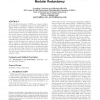17 search results - page 1 / 4 » Self-Testing of FPGA Delay Faults in the System Environment |
IOLTS
2000
IEEE
13 years 9 months ago
2000
IEEE
We propose a procedure for self-testing of an FPGA programmed to implement a user-defined function. The procedure is intended to improve the detectability of FPGA delay faults. Th...
IPPS
2005
IEEE
13 years 10 months ago
2005
IEEE
Modern internet and telephone switches consist of numerous VLSI-circuits operating at high frequencies to handle high bandwidths. It is beyond question that such systems must cont...
ITC
1997
IEEE
13 years 9 months ago
1997
IEEE
: Accurate diagnosis is an essential requirement in many testing environments, since it is the basis for any repair or replacement strategy used for chip or system fault-tolerance....
ASYNC
2000
IEEE
13 years 9 months ago
2000
IEEE
Self-timed systems often have to communicate with their environment through a clocked interface. For example, off-chip memory may require clocking and this can reduce the benefit...
FPGA
2010
ACM
13 years 11 months ago
2010
ACM
Triple Modular Redundancy (TMR) is a common reliability technique for mitigating single event upsets (SEUs) in FPGA designs operating in radiation environments. For FPGA systems t...

